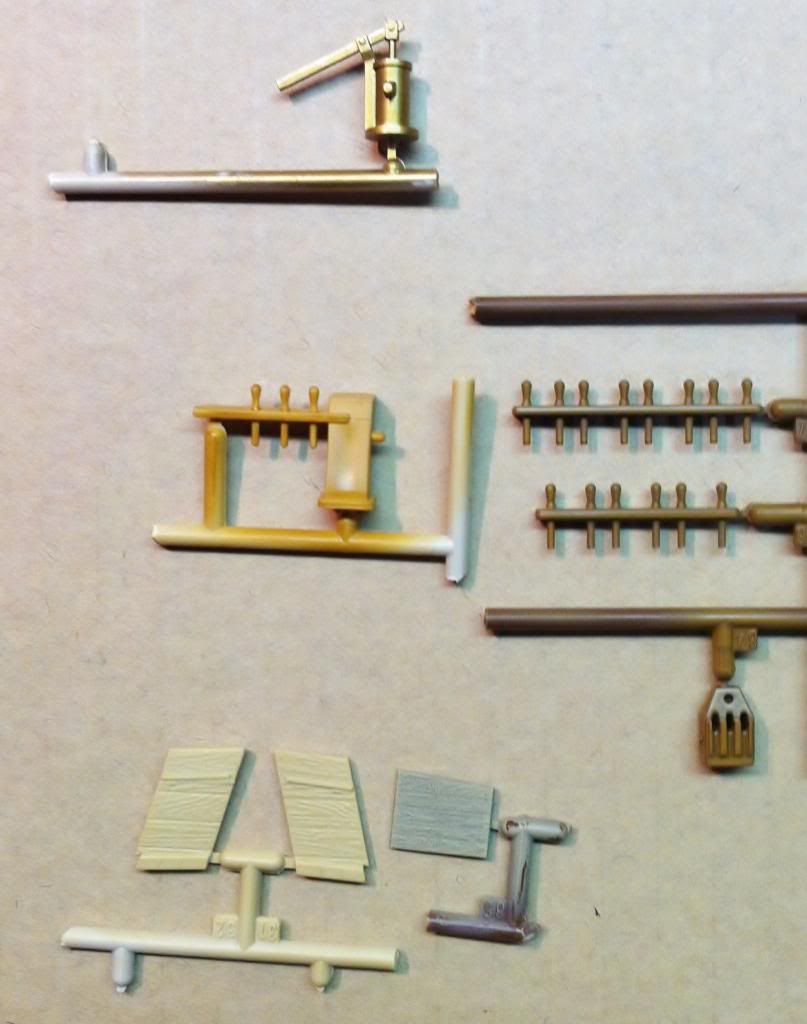Update:
I took advantage of a day off from work to get all the basecoats airbrushed on the Golden Hind parts today...took a few hours! But it was a great opportunity to test the new paints...Vallejo Model Air acrylics.
I realize that the following might be better suited to a different area of the forum, but oh well.
So my initial impression of the paint is good...which is a relief, because I've heard varying accounts of its performance. The Vallejo Model Air line offers many, many color choices, which is my primary reason for trying them out. Here's what I've gleaned so far:
+Sprays well through the airbrush, with no sputtering or spitting, and none of the six colors I used required any thinning. But they do separate after a time, and require thorough mixing before use.
+Easy cleanup. (typical for acrylic)
+Lays down pretty well.
+I had no problem with switching between Vallejo, Model Master, and Tamiya, and then back to Vallejo, just a simple cleanout by spraying some water through the brush. (compatibility seems good)
+Doesn't dry too fast...which means it probably bonds better to the plastic, and also doesn't get dry on the nozzle/tip of the airbrush and cause spraying problems...it was very easy to use.
+Tons of available colors! Lots of variety!
+Metallic gold came out really well. Acrylic metallics have a tendency to be troublesome, either they're uneven, or the flakes separate really fast, or they just look crummy and bland. The Gold from Vallejo was easy to use, didn't run, and made a nice solid coat...still, it's acrylic, and it doesn't have that super-shine that enamel metallics can give. Very good for an Acrylic.
There are a couple of things that sort of concern me:
-It's not what I'd call a good *hiding* paint. The same color sprayed on parts from differently-colored sprue parts come out very different. Recommend primer for continuity of color between different molded colors...which is a drag. I don't like to use primer, because I feel like every coat of paint applied lessens the crispness of detail on the parts. The main reason I use an airbrush is for the super-thin coats that can be applied. I find Model Master to hide under-colors quite a bit better.
-The finish of the paint seems to be more or less Satin, instead of a flat sheen. Which is kind of weird, since all the colors I used are tans, browns, sand, etc., colors that would generally be flat. The bottles don't indicate any level of sheen (flat, semi, gloss, etc.)...so I'm probably going to be hitting it with some Dullcote at the end. Perhaps it will *flatten* out after a day or two?
-Kinda spendy...Vallejo was almost 4 bucks a bottle(17mL), compared to MM, which runs almost a buck cheaper (14mL) at my LHS. Not hugely expensive, but it's a consideration.
Here's a pic showing some of the things I mentioned.
 On top, you can see the pump I painted with Gold. I know the pump would not be gold on a ship. but maybe brass (?)and I wanted to try the gold out, anyway. Below that, you can see to different sprues, each with some pinrail parts. Believe it or not, both of those sprues were painted with the SAME COLOR! Yes, so you can see how the underlying color of the molded plastic has a dramatic effect on how the Vallejo paint looks with a standard coat. And below that, another example of the same situation, this time with a different paint color. Two different sprues, molded in light and dark plastic, and the paint leaves a markedly different tone on each. Something to consider if you're going to use Vallejo paints.
On top, you can see the pump I painted with Gold. I know the pump would not be gold on a ship. but maybe brass (?)and I wanted to try the gold out, anyway. Below that, you can see to different sprues, each with some pinrail parts. Believe it or not, both of those sprues were painted with the SAME COLOR! Yes, so you can see how the underlying color of the molded plastic has a dramatic effect on how the Vallejo paint looks with a standard coat. And below that, another example of the same situation, this time with a different paint color. Two different sprues, molded in light and dark plastic, and the paint leaves a markedly different tone on each. Something to consider if you're going to use Vallejo paints.
Anyway, that's my impression of the Vallejo Model Air paints...pretty good stuff, but there are things to consider, especially when it comes to the color of base plastic. Once I get into some detail-painting with a brush, I'll update on how this stuff works OUTSIDE the airbrush!
Thanks for looking in!
David